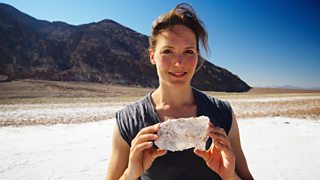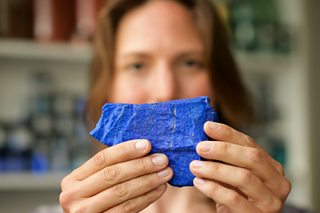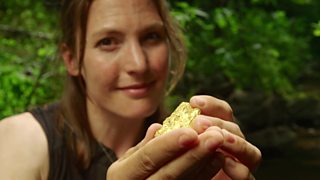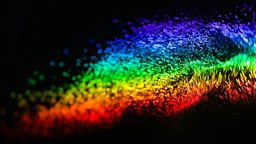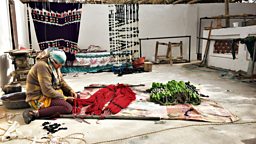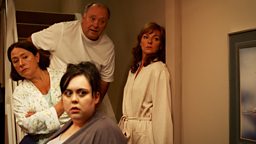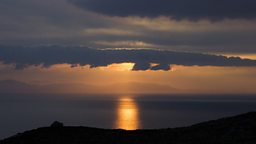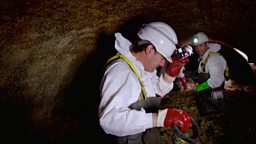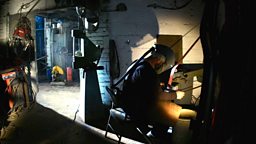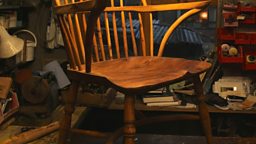Why are there no blue roses? ...and five other questions about colour
By Helen Czerski, Physicist and Presenter

Why are there no blue roses?
Dr Helen Czerski explains why blue flowers are rare in nature
Pink isn’t in the rainbow. Why not?
The rainbow shows us all the individual wavelengths of visible light in order, from the longer wavelengths (red) to the shortest that we can see (violet). These are the purest colours – each one has just a single type of light wave associated with it. But reality often isn’t so simple.
I’ve got a rose bush with bright pink roses outside my window, and I’m looking at it as I type this. The problem that my brain has is that the information from my eyes says that there is both red and violet light coming from the same rose.
A mixture of light from different regions of the rainbow is coming from the same place. What my brain needs to do is to interpret that information to distinguish it from objects that are just reflecting red light and those that are just reflecting violet. So it makes the interpretation that the rose is pink, a combination of red and violet.
We need to understand mixtures of the rainbow colours quickly, so our brain gives us a single colour for each mixture. This is what gives us the huge richness of colour in our world when there’s only the simple spectrum of the rainbow as the raw material. It’s all about combinations, and we see each different combination of lightwaves as a different single colour.
The reason that pink isn’t in the rainbow is that the rainbow shows colours in order. There’s nowhere in a rainbow where red and violet overlap, because they’re at opposite ends of the spectrum. So although pink is a real colour, it doesn’t have a place in the rainbow.
If glass is transparent and colourless, why can I see it?
The wonderful thing about glass and water and diamonds (all of which would be invisible if colour was the only thing that mattered) is that they can slow light down.
We have all heard that nothing can travel faster than the speed of light, and that the speed of light is an important fixed constant for physics. But that’s about how fast light travels in a vacuum, out in space where there’s nothing to interfere. When it’s travelling through anything else, light goes more slowly.
In water, it travels only 75% as fast as in empty space, and in glass it’s 69% of the full speed. And in diamond, light crawls along at 42% of its speed out in space.
That’s all well and good, but the change in speed has a consequence: as light hits the air-water or air-glass boundary and slows down, it changes direction.
Imagine a line of three or four people holding hands in a line, and jogging on a hard surface towards a sandpit. If they arrive at an angle, the people who hit the sand first have to slow down, but the faster ones on the tarmac are still going faster and get pulled around. So the line changes direction until all four are on the sand and going at the same slower speed.
When they come back out of the sandpit, the same process will happen again, but the other way around, and they’ll end up travelling in the original direction once more.
The reason we can see ‘invisible’ things like glass is that we can see how they mess up the light that’s coming from behind them. We can’t actually see the glass itself. But it’s bending the path of the light that’s coming through it, so we know where it is because of how it’s distorting the scene behind it.
Why do lobsters turn red when cooked?
The colour of a lobster is a bit like the brown you get when you mix all the colours in the paintbox together. The carapace of the lobster (the hard shell on the outside) has lots of different pigments in it: red, yellow, orange, black, and even blue. When these are all mixed together, you just see brown. But when you cook a lobster, the heat breaks down all the pigments except the red. And when red is the only colour left, the lobster looks red.
One fascinating consequence of this is that sometimes, a lobster will be born with a genetic mutation that means it only has some of the pigments. One in every 1 or 2 million lobsters is naturally orange, yellow or blue. And because they grow like mirror images of themselves, sometimes one side of the lobster has one pigment while the other side has another.
Why is seawater blue but tapwater colourless?
It’s one of those weird things in life – ask any child to draw water coming from a tap and they’ll use the blue crayon. But if the water coming from the tap really was blue, you’d certainly think twice before drinking it. Once satellites starting looking down on our planet, the confirmed our status as the blue planet – the oceans are certainly blue.
But surely what comes out of our taps is more-or-less the same as what’s in the ocean? The answer is that water really is blue, but only very faintly. You need a huge amount of it in one place to see the colour at all. As light travels into water, all the red and green light (all the non-blue end of the rainbow) gets absorbed after a few tens of metres.
So you’re left with blue. And the blue light that’s left will get bounced off tiny particles in the water, or perhaps bounced off the water molecules themselves, so it may eventually find its way back out to the surface. And so blue light comes from the oceans and they look blue.
Water from taps doesn't look blue because there’s too little of it to absorb any of the colours of the rainbow. What goes in is what comes out. So tapwater has no colour, but the oceans really are blue.
Why are there no green mammals?
It seems that green would be an obvious colour for some mammals, especially the smaller ones like rabbits and mice that spend their time hidden in greenery. The first lesson in disguise is surely to make yourself look like your surroundings! So why hasn’t evolution taken this route?
Firstly, we humans have better colour vision than almost all other mammals. All the rest – dogs, foxes, tigers, elephants etc - they are all dichromats. That means that they’re what we would call red-green colourblind. We have three types of cone cell in our eye to distinguish colours: red, green and blue.
All mammals apart from us and a few other primates only have green and blue cones. They can distinguish things that are yellow and blue, but they can’t tell the difference between red and green. So to a fox, a brown rabbit may already be pretty close to the colour of the greenery it’s hiding in.
The other issue is that it’s pretty hard to turn yourself green. Plants do it using chlorophyll, but there really any other other green pigments available in nature. Sloths cheat a bit by carrying round green algae on their fur, so they do look green-ish. But if it’s so hard, how do frogs and parrots manage it?
They get over the lack of green pigments by using a clever combination of colour types. They use structural colour – the sort of colour that you see when you hold a CD at an angle to white light. The shape of the surface means that only blue light is reflected, so that gives them a blue layer. And on top of that, they have a yellow pigment. The combination of blue and yellow looks green.
All that effort is worth it for a frog, but the rabbits seem to be getting on just fine without.
Feature article
-
![]()
Helen Czerski reveals how colour has written our planet's story.

